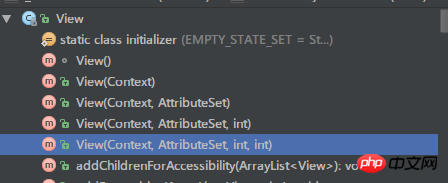在XML布局里给View设置点击事件的案例分享
view.setOnClickListener(onClickListener);
另外一种做法是直接在XML布局里面指定View点击时候的回调方法,首先需要在Activity中编写用于回调的方法,比如
public void onClickView(View view){ // do something }然后在XML设置View的android:onClick属性
<View android:layout_width="match_parent" android:layout_height="match_parent" android:onClick="onClickView" />
有的时候从XML布局里直接设定点击事件会比较方便(特别是在写DEMO项目的时候),这种做法平时用的人并不多,从使用方式上大致能猜出来,View应该是在运行的时候,使用反射的方式从Activity找到“onClickView”方法并调用,因为这种做法并没有用到任何接口。
接下来,我们可以从源码中分析出View是怎么触发回调方法的。

View有5个构造方法,第一个是内部使用的,平时在Java代码中直接创建View实例用的是第二种方法,而从XML布局渲染出来的View实例最后都是要调用第五种方法。
public View(Context context, @Nullable AttributeSet attrs, int defStyleAttr, int defStyleRes) { this(context); final TypedArray a = context.obtainStyledAttributes( attrs, com.android.internal.R.styleable.View, defStyleAttr, defStyleRes); for (int i = 0; i < N; i++) { int attr = a.getIndex(i); switch (attr) { …… // 处理onClick属性 case R.styleable.View_onClick: if (context.isRestricted()) { throw new IllegalStateException("The android:onClick attribute cannot " + "be used within a restricted context"); } final String handlerName = a.getString(attr); if (handlerName != null) { // 给当前View实例设置一个DeclaredOnClickListener监听器 setOnClickListener(new DeclaredOnClickListener(this, handlerName)); } break; } }}处理onClick属性的时候,先判断View的Context是否isRestricted,如果是就抛出一个IllegalStateException异常。看看isRestricted方法
/** * Indicates whether this Context is restricted. * * @return {@code true} if this Context is restricted, {@code false} otherwise. * * @see #CONTEXT_RESTRICTED */ public boolean isRestricted() { return false; }isRestricted是用于判断当前的Context实例是否出于被限制的状态,按照官方的解释,处限制状态的Context,会忽略某些特点的功能,比如XML的某些属性,很明显,我们在研究的android:onClick属性也会被忽略。
a restricted context may disable specific features. For instance, a View associated with a restricted context would ignore particular XML attributes.
不过isRestricted方法是Context中为数不多的有具体实现的方法(其余基本是抽象方法),这里直接返回false,而且这个方法只有在ContextWrapper和MockContext中有重写
public class ContextWrapper extends Context { Context mBase; @Override public boolean isRestricted() { return mBase.isRestricted(); }}public class MockContext extends Context { @Override public boolean isRestricted() { throw new UnsupportedOperationException(); }}ContextWrapper中也只是代理调用mBase的isRestricted,而MockContext是写单元测试的时候才会用到,所以这里的isRestricted基本只会返回false,除非使用了自定义的ContextWrapper并重写了isRestricted。
回到View,接着的final String handlerName = a.getString(attr);其实就是拿到了android:onClick="onClickView"中的“onClickView”这个字符串,接着使用了当前View的实例和“onClickView”创建了一个DeclaredOnClickListener实例,并设置为当前View的点击监听器。
/** * An implementation of OnClickListener that attempts to lazily load a * named click handling method from a parent or ancestor context. */private static class DeclaredOnClickListener implements OnClickListener { private final View mHostView; private final String mMethodName; private Method mMethod; public DeclaredOnClickListener(@NonNull View hostView, @NonNull String methodName) { mHostView = hostView; mMethodName = methodName; } @Override public void onClick(@NonNull View v) { if (mMethod == null) { mMethod = resolveMethod(mHostView.getContext(), mMethodName); } try { mMethod.invoke(mHostView.getContext(), v); } catch (IllegalAccessException e) { throw new IllegalStateException( "Could not execute non-public method for android:onClick", e); } catch (InvocationTargetException e) { throw new IllegalStateException( "Could not execute method for android:onClick", e); } } @NonNull private Method resolveMethod(@Nullable Context context, @NonNull String name) { while (context != null) { try { if (!context.isRestricted()) { return context.getClass().getMethod(mMethodName, View.class); } } catch (NoSuchMethodException e) { // Failed to find method, keep searching up the hierarchy. } if (context instanceof ContextWrapper) { context = ((ContextWrapper) context).getBaseContext(); } else { // Can't search up the hierarchy, null out and fail. context = null; } } final int id = mHostView.getId(); final String idText = id == NO_ID ? "" : " with id '" + mHostView.getContext().getResources().getResourceEntryName(id) + "'"; throw new IllegalStateException("Could not find method " + mMethodName + "(View) in a parent or ancestor Context for android:onClick " + "attribute defined on view " + mHostView.getClass() + idText); }}到这里就清楚了,当点击View的时候,DeclaredOnClickListener实例的“onClick”方法会被调用,接着会调用“resolveMethod”方法,使用反射的方式从View的Context中找一个叫“onClickView”方法,这个方法有一个View类型的参数,最后再使用反射调用该方法。要注意的是,“onClickView”方法必须是public类型的,不然反射调用时会抛出IllegalAccessException异常。
同时从源码也能看出,使用android:onClick设置点击事件的方式是从Context里面查找回调方法的,所以如果对于在Fragment的XML里创建的View,是无法通过这种方式绑定Fragment中的回调方法的,因为Fragment自身并不是一个Context,这里的View的Context其实是FragmentActivity,这也意味着使用这种方式能够快速地从Fragment中回调到FragmentActivity。
此外,从DeclaredOnClickListener类的注释也能看出android:onClick的功能,主要是起到懒加载的作用,只有到点击View的时候,才会知道哪个方法是用于点击回调的。
最后,特别需要补充说明的是,使用android:onClick给View设置点击事件,就意味着要在Activity里添加一个非接口的public方法。现在Android的开发趋势是“不要把业务逻辑写在Activity类里面”,这样做有利于项目的维护,防止Activity爆炸,所以尽量不要在Activity里出现非接口、非生命周期的public方法。因此,贸然使用android:onClick可能会“污染”Activity。
更多相关文章
- XML实体扩展攻击代码实例分享
- 详细介绍xml的使用方法总结
- 详细介绍解析Xml四种方法的示例代码
- Schema验证XML概念的实例代码详解
- XML数据解析的系统方法的代码分享
- 详解XML命名空间(XML Namespaces)介绍以及节点读取方法的示例代码
- FOR XML之RAW模式的代码实例详解
- 详解在XML文档中替换元素名称的方法(图)
- XML Spy实例代码详解(图)
